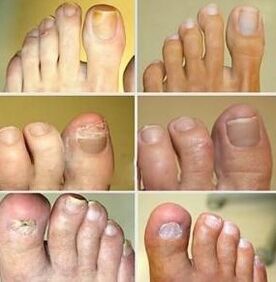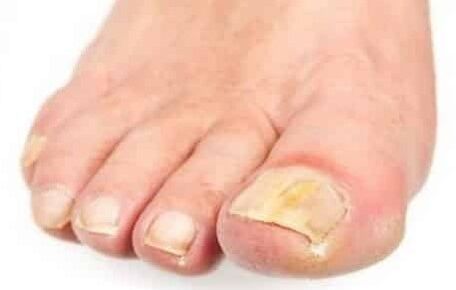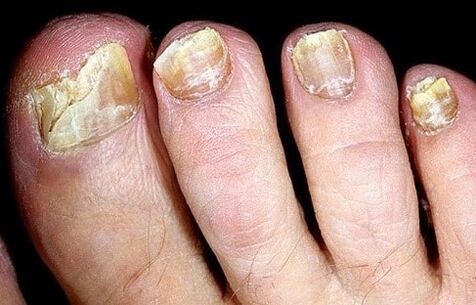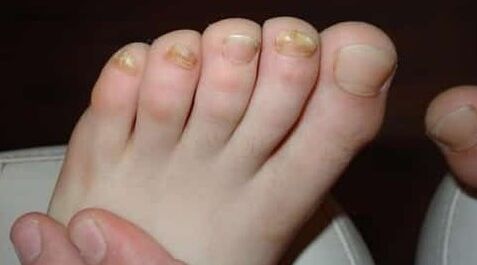Onychomycosis is a pathology that destroys nail plates.The fungus eats keratin - the base of the nail construction.The infection falls into the intercellular space and begins its separation.In the advanced stages, the pathology is able to affect the skin of the feet, the interconnecting area.

Causes of nail fungus
One infected with onychomycosis is quite easy.The infection can fall on the beach, the public spirit, the pool.A high probability of catching a fungus from relatives or infected acquaintances (using ordinary lives).
There are some main prerequisites that can provoke the introduction of the virus into the human body:
- A weak immune system - a decrease in protective forces due to infectious or inflammatory diseases;
- Vascular pathologies (blocking veins) violation of the work of the internal organs (diabetes), which lead to problems with blood circulation in the lower extremities;
- small injury to the skin (abrasive, micrococks, corn, corn) that were raised as a result of wearing tight shoes;
- ignoring diaper rash and intense sweating of the lower extremities;
- Violation of care measures - trying someone else's shoes, visiting public places without slippers and neglecting toe hygiene.
Types of nail fungus
Onychomycosis can provoke several types of fungi.Dermatophytes, for example, appear in the new form of the nail.There is a formation of yellow spots along the edges or in the middle of the plate.Moreover, longitudinal stripes can be observed along the affected area.
Yeast mushrooms provoke deformation of the nail plate.She is very sophisticated and begins to leave her place, becomes gray.Metabolism in damaged cells worsens, the furrows appear on the nail roll.Moreover, inflammation, edema, redness appear in the adjacent epidermis, the disappearance of the nail skin is observed.
Mold bacteria can damage the nail plate if there are already diseases that provoke nail food disorders.In this case, there is also a cloud of tile, a change in its color (from light and green yellow to brown and even black).
To detect the cause and pathogen of negative changes in the skin and nails, you should contact a specialist.An independent determination of the disease and its treatment without consulting with a physician can be fraught with consequences.
The stages of the disease

Nail mycosis gradually affects healthy cells.The disease has several stages of development, each of which has its own specific manifestations.
The first stage of onychomycosis (normotorophytic) has no bright manifestations.In most cases, it continues hidden.The first signs - the nail fades slightly, its color changes, microcrocytes and yellow spots are formed in the form of circuits or length, and tuberosity appears.A novice fungus can be associated with itching and burning.It is difficult to properly recognize infection at the initial stage, as the symptoms are similar to other diseases (psoriasis, liver pathology).
If treatment does not start on time, the disease will go to the next stage - hypertrophic.The nail thickens, dark.There is a deformity of the plate, crowning and its destruction.
The advanced form of nail disease is manifested by a strong thinning of the nail plate, which leads to its further rejection.The adjacent skin becomes blue, an unpleasant odor appears.
Symptoms
Onychomycosis most often affects nails in the legs, hands suffer less frequently.The disease begins with the thumb and little finger (the outer edge is affected), touching smoothly on all the plates.
The main symptoms of onycomycosis will help determine the fungal infection:
- the appearance of strips and stains of a white or green color under the nails;
- Tile cloud, a change in its color (from yellow to dark brown);
- redness and peel of the skin around the nail;
- the appearance of roughness in the legs and between the fingers;
- Mold formation on the nails.
Types of nail fungal diseases
Onychomycosis is usually classified by the appearance of affected areas.Since the classification feature is what the fungus looks like on the nails, it differs in three species, depending on the clinical manifestations:
- Atrophic, or onhholytic - in which the nail plate is significantly affected, at the rate of refusal from the nail bed;
- The hypertrophic appearance, in which it has lost its natural brightness, changes its color (bleach or, conversely, darkened) and the structure (more vulnerable) with the appearance of different types of deformities and even destroys even along the edges;
- Normotrophic - a type characterized by the lowest degree of damage, in which the nail plate does not thicken, remaining excellent and smooth, but still transformed externally due to the appearance of stains, lines and other visible changes in its natural transparency and color.

In foreign countries, there is another classification according to which fungi on the nails are divided into species depending on the specific place of the lesion:
- In total, in which the entire nail plate is covered by a pathogenic process;
- distal - the form of damage, localizing only on the free edge of the nail that lasts over the finger tip;
- Proximal, in which the edge of the plate appears under the nail roll is destroyed (opposite the free edge of the nail!);
- Side shape of damage, touching the side sides of the nail plate.
How does the pathology look like
Nail Diseases Fungi among the population have external similarities to other dermatological diseases of the negribic nature.Depending on the pathology phase, nails begin to look unhealthy because they lose natural luster and transparency.From smooth and even, they become thick and deformed, and are covered in different colors (often yellowish white or filthy).The soft tissues surrounding the keratin layer destroyed by a parasite are also involved in inflammatory, swollen reactions and ulcers.
If we consider the figure of the nail plate destruction in the perspective of the dynamics of the disease, then it is divided into three consecutive stages:
- In the first stage, there are practically no signs, except for the boredom of light, dots or stripes on the plate.
- In the so -called a pronounced phase, quickly replacing the initial one, all symptoms of onycomycosis become apparent.
- The advanced stage is the last degeneration of the nail, can be supplemented by the appearance of an unpleasant odor of decay tissue.
Reasons for nail deformity
Mold, yeast -like fungi and dermatophytic fungi cause infectious nail disease (onychomycosis), manifested by similar symptoms.All types of nail fungus in the legs or arms deform the nail plate, change transparency, shine, color.Changes in the nail are found not only with onycomycosis, but also for injuries, chronic paronichia (inflammation of the nail roller), psoriasis, wrist, dermatitis.Before drawing a conclusion about fungal infection, you must consider all possible options.
Fungal symptoms
There are different classifications of nail fungus, depending on the type and manifestation, they can have completely different signs and symptoms, so it is very important to determine it (psoriasis, eczema, lost lichen and dermatophy).Surface onycomycosis on the fingers manifests almost immediately after infection, consider the symptoms and signs of fungi on the nails of the feet and wings:
- Thick plate;
- Fragile, crumbly or torn nails not only near the edge but also across the surface;
- Distorted forms, scaly structure;
- The initial stage is the loss of brightness and elasticity;
- If the nail is blackened (not at the expense in the case where a person works regularly with coloring composition or mechanical parts);
- Nails collide under the skin;
- Disbacteriosis begins, perhaps a general decrease in immunity, strength, drowsiness;
- Itching between fingers and standing is especially pronounced in the child;
- Nail bed examination is a very common phenomenon and almost the last stage before full loss of nail, which is called onycolysis.You can feel pain in your fingers and find a slightly unpleasant odor;
- The skin becomes dry, cracks, a rash appears, perhaps even the appearance of blood or a sucon;
- A white or yellow circle of mold under the nail, depending on the variety of fungi, can be bright, dull, with prescribed edges and a mud structure.

Before starting active actions, it is necessary to minimize the negative impact of the external environment, to eliminateReasons why fungi appearedUnder the walking nails:
- A warm and wet environment is ideal for the growth of different microorganisms, try to dry your shoes all the time after walking, wear socks from natural materials that provide normal heat and air exchange;
- The fungus of the foot often appear due to poor immunity, you can simply get to the floor with your bare leg and get the infection, take vitamins to avoid this;
- Frequent nail extension can become one of the causes of onycomycosis, limit the procedure to 1 session to six months;
- The most complicated is charming - this is a fungus caused by active disputes.They penetrate the cavities between the nails and the fingers, can be in a sleeping phase for some time, and then grow significantly.Most often, they are infected in places of public use (swimming pools, showers, sun), while operating other people's shoes, etc.
Common Types of Prohibition Mycosis
There are many ways to get an infection with a fungus of the feet, but it is only possible with direct contact with the pathogen.Most often, this happens when using other people's shoes or contrary to personal hygiene rules.The fungus of the skin in the legs usually manifest through the destruction of the dermis, which is reflected in the form of peel.The epidermis lesions in this case are caused by the fact that the infection penetrates the deep layers of the skin, destroying its structure.
Modern medicine identifies the following options for damage to the fungus in the foot, each of which varies in its symptoms and treatment options:
- Inodallic mycosis is the most common form in the form of which the disease manifests itself.The symptoms usually localize between 3 and 4 fingers, less often between 4 and 5, looks like a crack covered with a white film.It is possible to secrete a certain amount of fluid, peel of the borders, and the appearance of diaper rash signs.Signs of interdigital legs of the feet can be associated with poor itching.Such a fungus on the toes can initially occur completely without symptoms, but in the future there is a significant change in the skin structure.
- Squamous hyperkeratotic fungi can be distinguished from other species of peel and severe keratinization that affect the epidermis.It is characteristic of people suffering from different types of dermatitis, mostly atopic.This is another type of disease that can be clearly seen what fungi are standing.The main symptom of the disease is the appearance of an erythema, a painful pink joint, in a affected area that has clear borders.It is associated with poor itching, leg cracks, dryness, pain, yellow and damage to the nail plates.Onychomycosis, usually accompanying this type of fungus, leads to nail stratification;
- Vesicular fungi are one of the rarest types of infection, which affects the skin of the feet.The disease took its name for the formation of vesicles - bubbles with liquid content, where erosion is then formed, which is dangerous for infection.The main signs that the vesiculosis of the fungus changes: the appearance of the bladder up to 1 centimeter, as well as poor itching;
- Deleted mushrooms.In the initial phase, there is a slight peel on the toes, as well as the appearance of small cracks, touching the upper layer of the epidermis externally.
- The fungus is double -headed, whose infection is found in medical practice in only 8% of patients infected with mycosis.Localized mainly localized in the only and the safe of the foot, manifests itself in the form of bubbles, gradually joining one, after which its gap followed by the formation of extensive erosion.The risk of a fungus of this type is the possibility of binding a bacterial infection, as pathogenic microorganisms penetrate easily through the resulting wound;
- Internet mycosis occurs not only independently, but also as a companion of a squamous form of the fungus.It manifests between the toes, characterized by itching and severe burns, diaper redness and the appearance of erosion;
- Onychomycosis is another common option of damage, which is a nail fungus.Usually develops from the free edge of the nail plate, the initial phase is characterized by the appearance of yellow spots, after which the disease progresses with relaxation and complete rest of the nail.Often accompanies other forms of fungal lesions;
- Candidate fungi, also called yeast erosion, which is located in the interdigital space.In this case, the fungus on the foot looks like the concentration of swollen areas of swollen skin, which can be surrounded by small -shaped pustules.

















